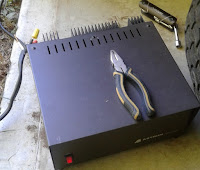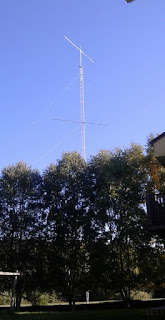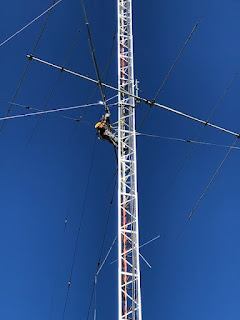When I described the mast for my new 140' (40 m) tower I deferred discussion about the rotator. In that article I showed a picture of the drive shaft and described how it would be coupled to the mast. Details were glossed over since I intended to do that in a future article -- this one -- now that the rotator is installed and (mostly) working.
My
original intent was to keep the second prop pitch motor in reserve for
temporary removal of the other for maintenance work. Since the 5 element
yagis for 15 and 20 meters would require a large and expensive rotator I
decided to use the prop pitch motor and shop for a third motor
to keep as a spare. I don't have one yet and there is no great rush.
When the mast was first installed it was left to spin freely in its bearings. With the upper 15 meter yagi installed it became a pretty effective weather vane, pointing downwind in a strong wind. A temporary grip holds the mast in a fixed position for antenna work (picture is in the mast article).
The fittings for the prop pitch motor on the tower and mast were made while the top tower sections were still on the ground. I knew then that the motor installation would be challenging. Unlike the chain drive system for the other tower this motor would be mounted upside down under the mast. Most prop pitch motors are used in this fashion despite the challenges of installation and removal on many types of tower.
The motor weighs ~42 lb (19 kg) so you either have mechanical means to support it while bolting it to the tower plate or have a second person on the tower holding it. On my tower there is the added complication of a tight fit for the motor and plate, making it impossible to install or remove when they are bolted together. Another complication is that there is so little space between the gear box housing and the adjacent tower girts that only 3 of the 6 mounting bolts can be fitted by hand.
Preparation
When I first acquired the two motors I bench tested them. Both worked as they should. Two years later one was installed on the 150' tower. Earlier this year I retested the second prop pitch motor, which it passed. I proceeded to partially disassemble it to check that it was in good condition.
My first concern was the grease. Unlike the apparently never touched first motor a previous owner (at least two back) cleaned out the original oil and heavily packed the gearbox with grease. I took a sample of the grease and put it outside overnight, where the -20° C temperature would test whether it was good enough for our cold winters. The grease passed the temperature challenge.
I left the sample exposed indoors for a few months to see if it would dry out. It did slightly and I concluded it was not a synthetic grease. Possibly it is snowmobile grease which is popular for rotator use by hams in Canada. I prefer synthetic grease for its excellent 4-season performance .
The three wires coming out the side of the motor are stranded AWG 12. Oxidation extended inside the insulation, which is not unusual with stranded copper wire. Replacing the wires involved a more complete disassembly which I chose to avoid. Since the wires were long I cut off the worst of the oxidation, then cleaned each of the 7 strands, rewound and tinned them with solder.
 After reassembly it didn't run. I pulled the motor off the chassis and cleaned the contact "fingers" and their receptacles. That fixed the problem. I may do a full refurbishment in future if only to ease my mind. Right now I don't want to spend the time, or risk damaging it without a spare on hand. I've never done a complete disassembly of a prop pitch motor so I am being cautious.
After reassembly it didn't run. I pulled the motor off the chassis and cleaned the contact "fingers" and their receptacles. That fixed the problem. I may do a full refurbishment in future if only to ease my mind. Right now I don't want to spend the time, or risk damaging it without a spare on hand. I've never done a complete disassembly of a prop pitch motor so I am being cautious.Cradle
There aren't any good attachment points on the small prop pitch motor to hold it in position under a tower plate other than the mounting holes and those need to be unencumbered. With two people on the tower you can brute force it with one taking its weight while the other bolts it in. Alas, there was only me up there.
Making it worse was that it was impossible to bolt it in unless the plate wasn't sitting on the tower girt. The gap between the two girts where I chose to mount it was too small to join them sideways and tilt in down onto the lower girt.
 Indeed, it was a struggle to maneouver the motor through the tower diagonals and legs -- there was barely room for it and difficult to do on the tower compared to rehearsal of the operation on the ground. Coming up underneath, again, would require a second person.
Indeed, it was a struggle to maneouver the motor through the tower diagonals and legs -- there was barely room for it and difficult to do on the tower compared to rehearsal of the operation on the ground. Coming up underneath, again, would require a second person.The solution was to build a cradle for the motor. I made it from odds and ends gathered from my extensive junk box. In the picture you can see the cradle being tested on the ground. It's little more than a 4.5" u-bolt, plate and stranded steel wire. The u-bolt slips on the motor and the wire is wrapped through the tower girt holes.
The gearbox is heavier than the motor so it tips inside the cradle. The tower girt acts limits the tilt. On the tower the cradle worked surprisingly well. With the cradle attached the prop pitch motor is lifted by a mounting hole, then wiggled through the side of the tower and dropped into the cradle with a minimum of expletive mumbling.
The hoist was disconnected, the plate dropped onto the motor and bolted. The wires were detached and the plate and motor assembly came to rest on the girt. The plate was then bolted to the girt. There are no pictures of the intermediately stages since, unfortunately, my hands were occupied with the work.
Weather seal
With the prop pitch motor upside down the crown gear and oil seal are fully exposed to the weather. The mating drive shaft on top is inadequate protection. Precipitation is driven sideways by strong winds at that height and will reach the motor base. The oil seal isn't designed for weather.
I created a two part wind and water baffle to resist water infiltration. A ridge of caulk about ¼" high around the plate opening for the crown gear is one half. By itself it is insufficient due to those winds. The second part is a plastic toroid cut from a plastic container that fits around the drive shaft crown gear. I trimmed it on the tower to fit inside the mounting bolt heads so that water runs off and not inward.
Time will tell how well this works but it looks effective. I will spray on some paint for UV protection. Should this not work out in practice I will devise something different next year.
A previous owner welded a T coupler to the external gear, into which a 1.66" OD pipe is threaded and held with set screws. One feature of the existing design is that water running down the pipe
interior exits from a open port on the coupler rather than onto the
motor.
For the present I am using it despite not being in great condition and of only modest strength.I will likely replace it next year. The pipe coupler will have to be sawn off and a new shaft welded on. The crown gear is less easily replaced so it must be handled with care.
The mounting system I devised allows for rapid installation and removal of this "drive shaft" for repair or replacement. The dimension of its replacement will be sized to fit.
The weight of the mast and antennas rests on an industrial thrust bearing. It can be spun by hand when the drive shaft isn't installed. To install the drive shaft it is angled into the upper coupler -- a 2.875" schedule 80 6061-T6 pipe -- that is centred and bolted to the 3.5" weight bearing mast coupler above. Further detail can be found in the mast article from earlier this year.
A 5/16" grade 8 bolt pierces the mast coupler and shaft. The bolt is the sole means of transferring torque between motor and mast. It is a potential weak point to be addressed in the redesign. When the drive shaft is centred on the bolt the ⅜" set screws are pressed against the shaft. The screws are large so that the tapped holes in the 6061-T6 coupler are resistant to wear. Nuts lock the screws.
The one tricky point is that the holes for the connecting bolt must be exactly aligned to install it. A grip on the mast is used to turn it until the bolt slips through. Doing it on a windless day is very helpful.
Notice that the set screws are not orthogonal to the connecting bolt. This configuration prevents the drive shaft from creeping along the bolt, and facilitates fine tuning centering of the drive shaft within the mast coupler. It works well in practice. The set screws don't have to be pressed hard against the mast since they are not involved with torque transfer.
Cable and loss
Approximately 130 meters of 10/2 NMWU electrical cable connects the motor to the shack. Other than on the tower and the aerial run from the edge of my yard to the switching systems at the tower near the house the cable is buried. It is not yet routed indoors since a new trench from tower to the house is delayed until I have a full set of cables prepared for the trench.
The installed prop pitch rotator was tested with a 13.8 VDC power supply set up outdoors. It is typical that DC motors operate with a lower voltage but at reduced power. Since I used half the required 24 VDC the motor speed is ¼ of normal (P = I²R), which works out to almost 5 minutes to turn 360°.
The resistance of AWG 10 wire is 0.0032 Ω/m so the return circuit resistance is ~1 Ω, including extra resistance for the smaller gauge ground (common) wire. An ohmmeter measurement of the cable agrees. Voltage is therefore lowered by a few volts, further slowing the motor.
Unfortunately the common wire is showing a higher and unstable resistance. It is likely due to a bad splice but the fault could be the internal motor contacts (previously mentioned as having been corrected). I haven't repaired the fault as of this writing but the motor tests fine although it is half the calculated speed with 13.8 VDC, so it is very very slow for the time being.
I let it run while I watched to ensure there was no binding in the mast system. It is fine. When I am next up the tower I will check the motor wires and connections.
Direction indicator and controller
There is no direction indicator. I've been considering alternative designs to couple a potentiometer to the drive shaft or mast and haven't yet selected one. If I don't get it done before winter I'll monitor its direction from the window, and illuminate it with a bright flashlight at night. I've done the same in the past with faulty direction indicators.
I have just the one controller for prop pitch motors. This winter I will modify it so that it will power either prop pitch rotator, but only one at a time since it doesn't have enough current to power both. I am planning an Arduino based direction indicator and motor control. It will be designed, assembled and coded over the winter when I have more time. Of course I'll still need to install a direction pot on the tower.
This will serve as an interim solution for rotating the upper yagis of my 15 and 20 meter stacks this winter. As you can see in the picture the upper 15 meter yagi is installed. The upper 20 meter yagi remains on the ground, delayed by a variety of non-radio chores that must be completed before the weather gets colder.
Slow or not, direction known or not, it is going to be used this winter season. Its limitations are things you learn to accommodate in your operating when you insist on home brewing these crazy projects.















